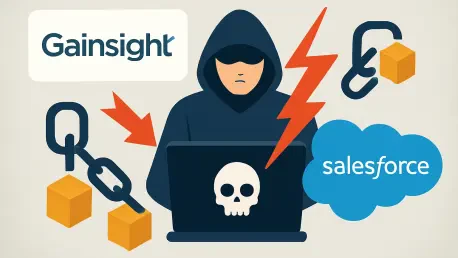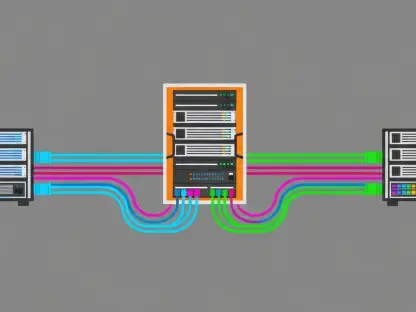In an era where digital ecosystems are increasingly interconnected, a recent cybersecurity breach involving Gainsight, a software company focused on customer retention, and Salesforce, a giant in customer relationship management, has sent shockwaves through the tech industry, exposing critical vulnerabilities. This incident, identified as a supply chain attack, targeted the integration between these two platforms, revealing weaknesses that extend far beyond a single company or product. The breach has not only disrupted operations for numerous businesses but also temporarily halted integrations with other major software providers such as Zendesk, HubSpot, and Gong. With potential data compromises affecting over 200 Salesforce customers, this event underscores a critical challenge in modern technology: the fragility of third-party connections in an otherwise robust digital infrastructure. As companies scramble to mitigate the damage, the incident serves as a stark reminder of the cascading effects such attacks can have across interconnected systems.
Unveiling the Breach Dynamics
The complexity of the supply chain attack on Gainsight and Salesforce reveals a sophisticated operation attributed to the ShinyHunters threat group, as reported by cybersecurity experts. This breach exploited the integration points between the two platforms, allowing unauthorized access that potentially jeopardized sensitive data across a wide range of users. Unlike direct attacks on core systems, supply chain incidents target the less visible but equally critical links between software providers, amplifying their impact. The fallout has been immediate, with several Gainsight products like Community – CC and Skilljar – SJ losing the ability to interact with Salesforce data. Meanwhile, integrations with other platforms have been paused pending a thorough investigation. This scenario illustrates how a single point of failure in a third-party connection can disrupt entire ecosystems, leaving businesses vulnerable and highlighting the urgent need for enhanced security measures at every level of software interaction.
Beyond the immediate operational disruptions, the breach has exposed a deeper systemic issue within the tech industry: the inherent risks of relying on interconnected software solutions. While Salesforce itself has not been found to have direct vulnerabilities in its core platform, the incident emphasizes that the strength of any system is only as good as its weakest link. In response, Salesforce swiftly revoked all active and refresh tokens linked to Gainsight applications to prevent further unauthorized access. Gainsight, for its part, has rotated multifactor credentials for critical systems and urged customers to update their security protocols. These actions, while necessary, reflect a reactive stance to a problem that demands proactive solutions. As investigations continue, the focus remains on understanding how such breaches occur through external connections and what steps can be taken to fortify these often-overlooked entry points against future threats.
Industry-Wide Implications and Responses
The broader implications of this supply chain attack extend far beyond the immediate parties involved, casting a spotlight on the tech industry’s collective vulnerability to such threats. Similar incidents, like a prior attack on Salesforce customers through another integration, indicate a troubling pattern where attackers exploit third-party connections rather than core systems. This trend underscores a critical gap in cybersecurity strategies, as companies often prioritize internal defenses while neglecting the risks posed by external partnerships. The temporary suspension of integrations with platforms like Zendesk and HubSpot, despite no direct evidence of compromise on their systems, reflects a cautious approach aimed at protecting users. This incident serves as a wake-up call for the industry to reassess how integrations are secured and monitored, pushing for standards that can prevent such cascading disruptions in an increasingly connected digital landscape.
Equally significant is the unified stance taken by affected companies to prioritize security over immediate functionality, a decision that speaks to a maturing industry response to cyber threats. Salesforce, for instance, has maintained a firm position against yielding to ransom demands in related incidents, signaling a commitment to resilience over capitulation. Gainsight’s proactive measures to strengthen its environment, coupled with ongoing forensic reviews by cybersecurity experts, demonstrate a dedication to restoring trust. These efforts, while commendable, also highlight the enormity of the challenge in safeguarding interconnected systems. As the tech sector grapples with these evolving threats, collaboration among stakeholders becomes paramount. Companies must share insights and best practices to build a more resilient framework that can withstand the sophisticated tactics of modern cybercriminals, ensuring that customer data remains protected.
Strengthening Defenses for Tomorrow
Reflecting on the aftermath of this breach, it became clear that the tech industry had faced a pivotal moment in addressing supply chain vulnerabilities. The coordinated response from Gainsight and Salesforce, including token revocations and credential updates, mitigated immediate risks and set a precedent for rapid action. However, the temporary deactivation of key integrations and the operational hiccups that followed revealed the delicate balance between security and functionality. This incident prompted a broader dialogue on the need for robust protocols that secure third-party connections without sacrificing efficiency, a conversation that gained momentum among industry leaders.
Looking ahead, the path forward demands a shift toward preemptive measures and collaborative innovation to fortify digital ecosystems against future supply chain attacks. Establishing stricter security standards for integrations, investing in real-time monitoring tools, and fostering transparency among software providers emerged as critical steps. The lessons learned from this breach underscored that protecting customer trust requires not just reaction but anticipation, ensuring that interconnected systems can withstand the evolving landscape of cyber threats.









